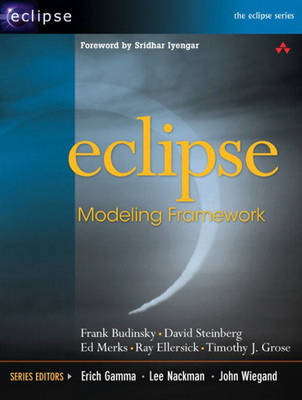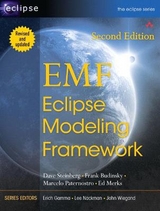
Eclipse Modeling Framework
Addison-Wesley Educational Publishers Inc (Verlag)
978-0-13-142542-2 (ISBN)
- Titel erscheint in neuer Auflage
- Artikel merken
FRANK BUDINSKY, leader of the Eclipse EMF project, is co-architect and an implementer of the EMF framework and code generator. An engineer in IBM's Software Group, Frank has been involved in the design of frameworks and generators for several years, including design lead for the IBM/Taligent Compound Document Framework in VisualAge/C++, the Composed Business Object Builder in Component Broker, and most recently a common framework for mapping tools in WebSphere Studio. DAVID STEINBERG is a core member of the EMF development team in IBM's Software Group. Dave has contributed extensively to the design and implementation of both the runtime and code generator components of EMF. ED MERKS is project leader and lead architect of the XSD technology project and a co-architect of the EMF tools project, both at Eclipse. Ed develops software at the IBM Toronto Laboratory and has many years of in-depth experience in the design and implementation of languages and their supporting environments, including a Ph.D. on the subject. RAYMOND ELLERSICK is an engineer in IBM's Software Group. A member of the EMF team, Ray is a key contributor to the design of EMF and was previously the development lead for IBM's earlier modeling framework from which much of EMF evolved. TIMOTHY J. GROSE, a software engineer at the IBM Silicon Valley Laboratory, develops applications using XML and XMI technologies, including design and implementation of the default serialization support in EMF.
Foreword by Sridhar Iyengar.
Foreword by Dr. Lee R. Nackman.
Preface.
References.
I. EMF OVERVIEW.
1. Eclipse.
The Projects. The Eclipse Platform. More Information.
2. Introducing EMF.
Unifying Java, XML, and UML. Modeling vs Programming. Defining the Model. Generating Code. The EMF Framework. EMF and Modeling Standards.
3. Model Editing with EMF.Edit.
Displaying and Editing EMF Models. Item Providers. Command Framework. Generating EMF.Edit Code.
4. Using EMF—A Simple Overview.
Example Model: The Primer Purchase Order. Creating EMF Models and Projects. Generating Code. Running the Application. Continuing Development.
II. DEFINING EMF MODELS.
5. Ecore Modeling Concepts.
Core Model Uses. The Ecore Kernel. Structural Features. Behavioral Features. Classifiers. Packages and Factories. Annotations. Modeled Data Types.
6. Java Source Code.
Java Specification for Packages. Java Specification for Classes. Java Specification for Enumerations. Java Specification for Data Types. Java Specification for Maps.
7. XML Schema.
Schema Definition of Packages. Schema Definition of Classes. Schema Definition of Attributes. Schema Definition of References. Schema Simple Types.
8. UML.
UML Packages. UML Specification for Classifiers. UML Specification for Attributes. UML Specification for References. UML Specification for Operations.
III. USING THE EMF GENERATOR.
9. EMF Generator Patterns.
Modeled Classes. Attributes. References. Operations. Class Inheritance. Reflective Methods. Factories and Packages. Switch Classes and Adapter Factories. Customizing Generated Classes.
10. EMF.Edit Generator Patterns.
Item Providers. Item Provider Adapter Factories. Editor. Action Bar Contributor. Wizard. Plug-Ins.
11. Running the Generators.
EMF Code Generation. The Generator GUI. The Command-Line Generator Tools. The Template Format.
12. Example—Implementing a Model and Editor.
Getting Started. Generating the Model. Implementing Volatile Features. Implementing Data Types. Running the ExtendedPO2 Editor. Restricting Reference Targets. Splitting the Model into Multiple Packages. Editing Multiple Resources Concurrently.
IV. PROGRAMMING WITH EMF.
13. EMF Client Programming.
Packages and Factories. The EMF Persistence API. EMF Resource Implementations. Adapters. Working with EMF Objects. Dynamic EMF.
14. EMF.Edit Programming.
Overriding Commands. Customizing Views.
V. EMF API.
15. The org.eclipse.emf.common Plug-In.
The org.eclipse.emf.common Package. The org.eclipse.emf.common.command Package. The org.eclipse.emf.common.notify Package. The org.eclipse.emf.common.util Package.
16. The org.eclipse.emf.common.ui Plug-In.
The org.eclipse.emf.common.ui Package. The org.eclipse.emf.common.ui.celleditor Package. The org.eclipse.emf.common.ui.viewer Package.
17. The org.eclipse.emf.ecore Plug-In.
The org.eclipse.emf.ecore Package. The org.eclipse.emf.ecore.plugin Package. The org.eclipse.emf.ecore.resource Package. The org.eclipse.emf.ecore.util Package.
18. The org.eclipse.emf.ecore.xmi Plug-In.
The org.eclipse.emf.ecore.xmi Package.
VI. EMF.EDIT API.
19. The org.eclipse.emf.edit Plug-In.
The org.eclipse.emf.edit Package. The org.eclipse.emf.edit.command Package. The org.eclipse.emf.edit.domain Package. The org.eclipse.emf.edit.provider Package. The org.eclipse.emf.edit.provider.resource Package. The org.eclipse.emf.edit.tree Package. The org.eclipse.emf.edit.tree.provider Package. The org.eclipse.emf.edit.tree.util Package.
20. The org.eclipse.emf.edit.ui Plug-In.
The org.eclipse.emf.edit.ui Package. The org.eclipse.emf.edit.ui.action Package. The org.eclipse.emf.edit.ui.celleditor Package. The org.eclipse.emf.edit.ui.dnd Package. The org.eclipse.emf.edit.ui.provider Package.
Appendix A: UML Notation.
Classes and Interfaces. Enumerations and Data Types. Class Relationships.
Appendix B: Summary of Example Models.
SimplePO. PrimerPO. ExtendedPO1. ExtendedPO2. ExtendedPO3.
Index.
| Erscheint lt. Verlag | 27.8.2003 |
|---|---|
| Verlagsort | New Jersey |
| Sprache | englisch |
| Maße | 179 x 238 mm |
| Gewicht | 1064 g |
| Themenwelt | Informatik ► Grafik / Design ► Digitale Bildverarbeitung |
| Mathematik / Informatik ► Informatik ► Web / Internet | |
| ISBN-10 | 0-13-142542-0 / 0131425420 |
| ISBN-13 | 978-0-13-142542-2 / 9780131425422 |
| Zustand | Neuware |
| Haben Sie eine Frage zum Produkt? |
aus dem Bereich



